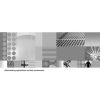Differential Neural Networks for Robust Nonlinear Control Identification State Estimation and Trajectory Tracking 1st Edition by Alexander Poznyak, Sanchez Edgar, Yu Wen ISBN 9789812811295 981281129X
$50.00 Original price was: $50.00.$35.00Current price is: $35.00.
Differential Neural Networks for Robust Nonlinear Control Identification State Estimation and Trajectory Tracking 1st Edition by Alexander Poznyak, Sanchez Edgar, Yu Wen – Ebook PDF Instant Download/Delivery: 9789812811295 ,981281129X
Full download Differential Neural Networks for Robust Nonlinear Control Identification State Estimation and Trajectory Tracking 1st Edition after payment
![]()
Product details:
ISBN 10: 981281129X
ISBN 13: 9789812811295
Author: Alexander Poznyak, Sanchez Edgar, Yu Wen
Differential Neural Networks for Robust Nonlinear Control Identification State Estimation and Trajectory Tracking 1st Edition Table of contents:
I Theoretical Study
1 Neural Networks Structures
1.1 Introduction
1.2 Biological Neural Networks
1.3 Neuron Model
1.4 Neural Networks Structures
1.4.1 Single-Layer Feedforward Networks
1.4.2 Multilayer Feedforward Neural Networks
1.4.3 Radial Basis Function Neural Networks
1.4.4 Recurrent Neural Networks
1.4.5 Differential Neural Networks
1.5 Neural Networks in Control
1.5.1 Identification
1.5.2 Control
1.6 Conclusions
1.7 References
2 Nonlinear System Identification: Differential Learning
2.1 Introduction
2.2 Identification Error Stability Analysis for Simplest Differential Neural Networks without Hidden
2.2.1 Nonlinear System and Differential Neural Network Model
2.2.2 Exact Neural Network Matching with Known Linear Part
2.2.3 Non-exact Neural Networks Modelling: Bounded Unmodelled Dynamics Case
2.2.4 Estimation of Maximum Value of Identification Error for Nonlinear Systems with Bounded Unmodel
2.3 Multilayer Differential Neural Networks for Nonlinear System On-line Identification
2.3.1 Multilayer Structure of Differential Neural Networks
2.3.2 Complete Model Matching Case
2.3.3 Unmodelled Dynamics Presence
2.4 Illustrating Examples
2.5 Conclusion
2.6 References
3 Sliding Mode Identification: Algebraic Learning
3.1 Introduction
3.2 Sliding Mode Technique: Basic Principles
3.3 Sliding Model Learning
3.4 Simulations
3.5 Conclusion
3.6 References
4 Neural State Estimation
4.1 Nonlinear Systems and Nonlinear Observers
4.1.1 The Nonlinear State Observation Problem
4.1.2 Observers for Autonomous Nonlinear System with Complete Information
4.1.3 Observers for Controlled Nonlinear Systems
4.2 Robust Nonlinear Observer
4.2.1 System Description
4.2.2 Nonlinear Observers and The Problem Setting
4.2.3 The Main Result on The Robust Observer
4.3 The Neuro-Observer for Unknown Nonlinear Systems
4.3.1 The Observer Structure and Uncertainties
4.3.2 The Signal Layer Neuro Observer without A Delay Term
4.3.3 Multilayer Neuro Observer with Time-Delay Term
4.4 Application
4.5 Concluding Remarks
4.6 References
5 Passivation via Neuro Control
5.1 Introduction
5.2 Partially Known Systems and Applied DNN
5.3 Passivation of Partially Known Nonlinear System via DNN
5.3.1 Structure of Storage Function
5.3.2 Thresholds Properties
5.3.3 Stabilizing Robust Linear Feedback Control
5.3.4 Situation with Complete Information
5.3.5 Two Coupled Subsystems Interpretation
5.3.6 Some Other Uncertainty Descriptions
5.4 Numerical Experiments
5.4.1 Single link manipulator
5.4.2 Benchmark problem of passivation
5.5 Conclusions
5.6 References
6 Neuro Trajectory Tracking
6.1 Tracking Using Dynamic Neural Networks
6.2 Trajectory Tracking Based Neuro Observer
6.2.1 Dynamic Neuro Observer
6.2.2 Basic Properties of DNN-Observer
6.2.3 Learning Algorithm and Neuro Observer Analysis
6.2.4 Error Stability Proof
6.2.5 Tracking Error Analysis
6.3 Simulation Results
6.4 Conclusions
6.5 References
II Neurocontrol Applications
7 Neural Control for Chaos
7.1 Introduction
7.2 Lorenz System
7.3 Duffing Equation
7.4 Chua’s Circuit
7.5 Conclusion
7.6 References
8 Neuro Control for Robot Manipulators
8.1 Introduction
8.2 Manipulator Dynamics
8.3 Robot Joint Velocity Observer and RBF Compensator
8.4 PD Control with Velocity Estimation and Neuro Compensator
8.5 Simulation Results
8.5.1 Robot’s Dynamic Identification based on Neural Network
8.5.2 Neuro Control for Robot
8.5.3 PD Control for robot
8.6 Conclusion
8.7 References
9 Identification of Chemical Processes
9.1 Nomenclature
9.2 Introduction
9.3 Process Modeling and Problem Formulation
9.3.1 Reactor Model and Measurable Variables
9.3.2 Organic Compounds Reactions with Ozone
9.3.3 Problem Setting
9.4 Observability Condition
9.5 Neuro Observer
9.5.1 Neuro Observer Structure
9.5.2 Basic Assumptions
9.5.3 Learning Law
9.5.4 Upper Bound for Estimation Error
9.6 Estimation of the Reaction Rate Constants
9.7 Simulation Results
9.7.1 Experiment 1 (standard reaction rates)
9.7.2 Experiment 2 (more quick reaction)
9.8 Conclusions
9.9 References
10 Neuro-Control for Distillation Column
10.1 Introduction
10.2 Modeling of A Multicomponent Distillation Column
10.3 A Local Optimal Controller for Distillation Column
10.4 Application to Multicomponent Nonideal Distillation Column
10.5 Conclusion
10.6 References
11 General Conclusions and future work
12 Appendix A: Some Useful Mathematical Facts
12.1 Basic Matrix Inequality
12.2 Barbalat’s Lemma
12.3 Frequency Condition for Existence of Positive Solution to Matrix Algebraic Riccati Equation
12.4 Conditions for Existence of Positive Solution to Matrix Differential Riccati Equation
12.5 Lemmas on Finite Argument Variations
12.6 References
13 Appendix B: Elements of Qualitative Theory of ODE
13.1 Ordinary Differential Equations: Fundamental Properties
13.1.1 Autonomous and Controlled Systems
13.1.2 Existence of Solution for ODE with Continuous RHS
13.1.3 Existence of Solution for ODE with Discontinuous RHS
13.2 Boundness of Solutions
13.3 Boundness of Solutions “On Average”
13.4 Stability “in Small”, Globally, “in Asymptotic” and Exponential
13.4.1 Stability of a particular process
13.4.2 Different Types of Stability
13.4.3 Stability Domain
13.5 Sufficient Conditions
13.6 Basic Criteria of Stability
13.7 References
14 Appendix C: Locally Optimal Control and Optimization
14.1 Idea of Locally Optimal Control Arising in Discrete Time Controlled Systems
14.2 Analogue of Locally Optimal Control for Continuous Time Controlled Systems
14.3 Damping Strategies
14.3.1 Optimal control
14.4 Gradient Descent Technique
14.5 References
Index
People also search for Differential Neural Networks for Robust Nonlinear Control Identification State Estimation and Trajectory Tracking 1st Edition:
differential neural network
differential networks
a deep learning library for solving differential equations
a dynamic near-optimal algorithm for online linear programming
Tags:
Alexander Poznyak,Sanchez Edgar,Yu Wen,Differential Neural Networks



